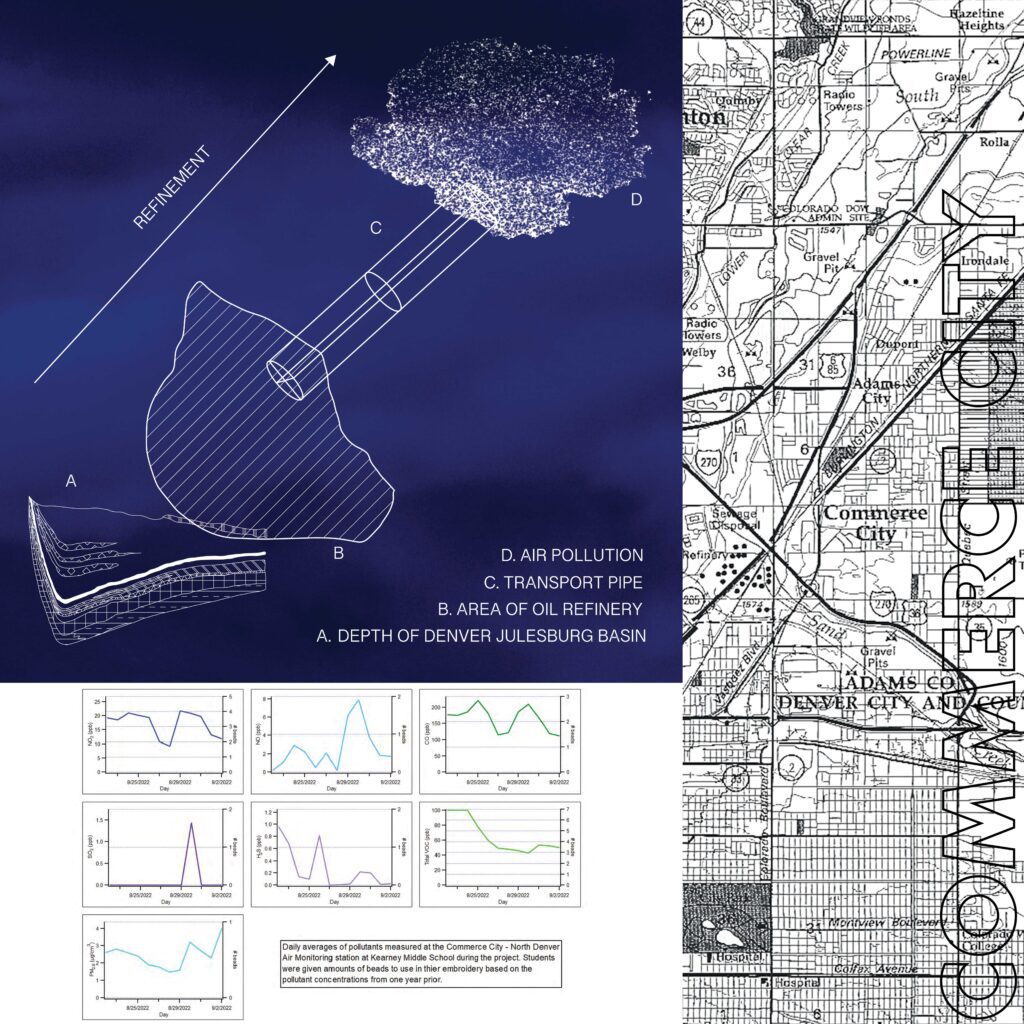
At the start of a new school year, students at Kearney Middle School in Commerce City collaborated with a scientist and artist to explore the impacts of pollution on local air quality. In addition to air monitoring instruments permanently located at the school as a part of the CCND Air Quality Monitoring program, an air quality instrument was installed at the school for two weeks. During this time students created fabric and bead embroidery pieces based on air pollution data coming from their region. Originally placed on a sculpture housing the instrument, the cloud embroidery pieces are displayed here on blueprint drawings of air monitoring equipment and include text excerpts from student’s reflections on the project and local pollution.
As a part of the exhibition, Kearney middle school students’ writing and embroidery pieces about air quality and air pollution are incorporated into blueprint drawings on fabric.
Art, Science, Place, and Community
This project is based on collaborations with students and teachers at the Kearney Middle School in Commerce City, CO. The school is located in a region of poor air quality, and some local industries have been required to install air monitors at schools to give the community access to real-time pollution data.
We installed a particle counter within a sculpture at Kearny Middle School to see if data from both the counter and the existing air monitor could be combined to study air particle formation in the region. During the particle counter’s installation, we asked students to elaborate on community perspectives of air pollution through artmaking and science research. Kearney art students took air monitor data from their school and translated it into bead and thread embroidery clouds that told stories about the environment. Kearney science students researched the six compounds measured at Commerce City schools and created posters to share with the rest of the school. As a part of the exhibition, Kearney middle school students’ writing and embroidery pieces about air quality and air pollution are incorporated into blueprint drawings on fabric.
What you can do to address this issue
There are many resources on air pollution in the Front Range. For data and community action specific to Commerce City, see CCND Air and local organization Cultivando’s website for more details. For a broader look at air pollution in the region, see Boulder Atmosphere Innovation Research. Purple air monitors can be found nationwide and offer real-time data maps of different air pollutants.
Environmental and Social Issues
The Front Range has elevated levels of air pollution, especially near industrial sites such as the Suncor Oil Refinery. Air pollutants, such as ozone, hydrogen sulfide, nitrogen oxide compounds and particulate matter, have an adverse effect on health and negatively impact the environment. Ozone alert days and smog visual obstructions are examples of poor air quality in the Denver Metro region.
Science Integrated into the Artwork
Due to the large amount of traffic in and around the city, as well as its proximity to the Rocky Mountains, the Denver Metro area experiences a lot of air pollution. Cars and other activities emit pollutants, which, due to the weather patterns generated by the mountains, can then be trapped nearby and close to the ground. Some of these pollutants react in sunlight to generate smog and ozone. Air pollutants such as ozone, carbon monoxide and some particulate matter can be harmful to human health, while others may have a smaller direct impact on health but can participate in other processes in the atmosphere that affect climate or weather patterns. In addition to the general pollution that comes from a large city, there are also point sources of specific pollutants, such as the Suncor refinery in Commerce City. This refinery has a history of exceeding permitted emission limits. In response to concerns about the refinery’s emissions, they started Commerce City-North Denver Air Monitoring, for which air monitors have been placed in various locations in Commerce City and North Denver. The main pollutants measured at these monitoring stations are nitric oxide (NO), nitrogen dioxide (NO2), hydrogen sulfide (H2S), sulfur dioxide (SO2), carbon monoxide (CO), particulate matter smaller than 2.5 μm (PM2.5) and volatile organic compounds (VOCs). Specific information about these pollutants is available on the CCND Air website, but all of these can have negative impacts on health.
The artwork shown above is located in the Colorado State Capitol through October 16, 2023.

